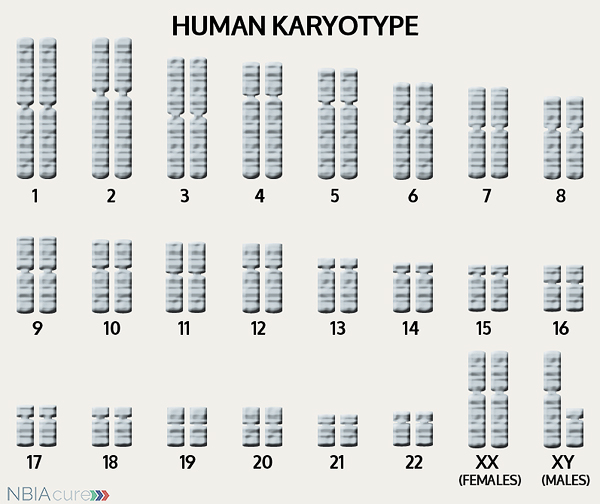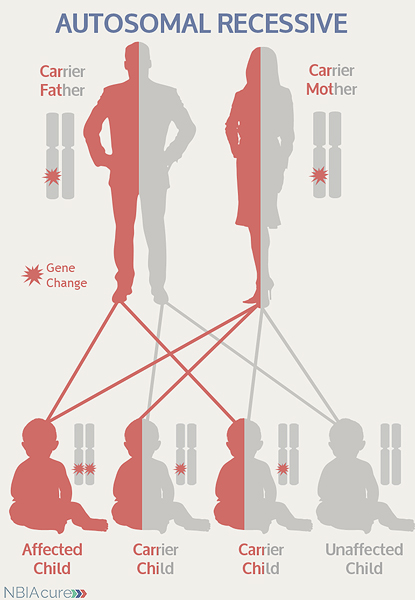Woodhouse-Sakati syndrome is an NBIA disorder characterized by both neurologic and endocrine symptoms.
SYMPTOMS
The first symptoms of Woodhouse-Sakati syndrome are typically found in individuals ranging from age 10 to the early 20s.
Common symptoms include:
Dystonia (involuntary muscle contraction and spasms)
- May be generalized or focal (located in one location)
Other muscle problems
- Choreoathetosis
- A condition in which chorea (involuntary, rapid, jerky movements) occur along with athetosis (relatively slow, writhing motions).
- Difficulty using or controlling the muscles of the mouth, tongue, larynx or vocal cords which are used to make speech.
- This can make a person’s speech difficult to understand in several different ways, including stuttering, slurring, or soft or raspy speech.
Hypogonadism (underdeveloped testes or ovaries)
- Often results in delayed puberty
- Causes low estradiol or testosterone levels
Alopecia (hair loss)
Diabetes
- Causes individuals to have a high level of sugar in their blood
- Blood tests show low serum insulin levels
Sensorineural deafness
- Hearing loss caused by a problem with cranial (brain) nerve VIII, the inner ear or the central processing centers of the brain
Cognitive (mental) decline
CAUSE/GENETICS
 The human body is made up of millions of cells. Inside every cell there is a structure called DNA, which is like an instruction book. DNA contains detailed steps about how all the parts of the body are put together and how they work. However, DNA contains too much information to fit into a single “book,” so it is packaged into multiple volumes called chromosomes. Humans typically have 46 total chromosomes that are organized in 23 pairs. There are two copies of each chromosome because we receive one set of 23 chromosomes from our biological mother and the other set of 23 from our biological father. Chromosomes 1-22 are called autosomes and the last pair is called the sex chromosomes because they determine a person’s gender. Females have two X chromosomes and males have one X and one Y.
The human body is made up of millions of cells. Inside every cell there is a structure called DNA, which is like an instruction book. DNA contains detailed steps about how all the parts of the body are put together and how they work. However, DNA contains too much information to fit into a single “book,” so it is packaged into multiple volumes called chromosomes. Humans typically have 46 total chromosomes that are organized in 23 pairs. There are two copies of each chromosome because we receive one set of 23 chromosomes from our biological mother and the other set of 23 from our biological father. Chromosomes 1-22 are called autosomes and the last pair is called the sex chromosomes because they determine a person’s gender. Females have two X chromosomes and males have one X and one Y.
If DNA is the body’s instruction book and it is stored in multiple volumes (called chromosomes), then genes would be the individual chapters of those books. Genes are small pieces of DNA that regulate certain parts or functions of the body. Sometimes multiple genes (or chapters) are needed to control one function. Other times, just one gene (or chapter) can influence multiple functions. Since there are two copies of each chromosome, there are also two copies of each gene. In some gene pairs, both copies need to be expressed (or turned on) in order for them to do their job correctly. For other genes pairs, only one copy needs to be expressed.
When a single cell in the human body divides and replicates, its DNA is also replicated. This replication process is usually very accurate but sometimes the body can make a mistake and create a “typo” (or mutation). Just like a typo in a book, a mutation in the DNA can be unnoticeable, harmless, or serious. A mutation with serious consequences can result in a part of the body not developing correctly or a particular function not working properly.
In the case of NBIA disorders, changes in certain genes cause a person to develop their particular type of NBIA. Changes in these NBIA genes lead to the groups of symptoms we observe, although we do not yet understand how the changed genes cause many of these findings. DCAF17 is the only gene known to cause Woodhouse-Sakati syndrome. The DCAF17 gene’s main job is to tell the body’s cells how to make a protein called DCAF17. It is not yet clear to us how a decrease in this protein eventually leads to iron accumulation in the brain
As mentioned earlier, humans have a total of 23 pairs of chromosomes. Half of these chromosomes are passed down (or inherited) from the biological mother and half from the biological father. The way in which a gene carrying a mutation is passed down from parents to child varies from gene to gene. The DCAF17 gene that is altered in those with Woodhouse-Sakati syndrome is inherited in an autosomal recessive manner.
“Autosomal” refers to the fact that the DCAF17 gene is located on chromosome 2, which is one of the autosomes (chromosome pairs 1-22). Since the sex chromosomes are not involved, males and females are equally likely to inherit a mutation located in the autosomes. “Recessive” refers to the fact that a mutation must be present in both copies of the DCAF17 gene for a person to have Woodhouse-Sakati syndrome. If an individual has only one DCAF17 mutation, then they are called a “carrier” for Woodhouse-Sakati syndrome. Carriers do not have health problems related to the mutation and often do not know they carry a recessive gene mutation. However, if two Woodhouse-Sakati syndrome carriers have a child together, then there is a 25% chance that they will both pass on their recessive DCAF17 gene mutations and have a child with Woodhouse-Sakati syndrome.
 As seen in the image to the left, in a pregnancy between two Woodhouse-Sakati syndrome carriers:
As seen in the image to the left, in a pregnancy between two Woodhouse-Sakati syndrome carriers:
- There is a 25% chance of the child having Woodhouse-Sakati syndrome
- There is a 50% chance that the child will be a carrier like his/her parents
- There is a 25% chance that the child will not have Woodhouse-Sakati syndrome or be a carrier
DIAGNOSIS & TESTING
A brain MRI is a standard diagnostic tool for all NBIA disorders. MRI stands for magnetic resonance imaging. An MRI produces a picture of the body that is created using a magnetic field and a computer. The technology used in an MRI is different from that of an x-ray. An MRI is painless and is even considered safe to do during pregnancy. Sometimes an MRI is done of the whole body, but more often, a doctor will order an MRI of one particular part of the body.
Evidence of iron accumulation on a brain MRI is often an important clue leading to diagnosis. A T2 sequence is the preferred type of MRI for NBIA diagnosis because it is highly sensitive to the detection of brain iron.
MRI findings for Woodhouse-Sakati syndrome include:
- Hypointensity (darkness) in the globus pallidus and substantia nigra on T2 MRI
- The dark patches indicate iron accumulation
- Only seen in some cases
A biochemical (blood) test would also show low insulin growth factor-1 levels.
Diagnosis of Woodhouse-Sakati syndrome is confirmed through genetic testing of the DCAF17 gene to find two gene changes. Genetic testing begins with sequence analysis, and if no gene changes are found, then it continues on to deletion/duplication analysis.
Very rarely, an individual with the signs and symptoms of Woodhouse-Sakati syndrome will have only one or even no DCAF17 gene changes identified. This can happen because the genetic testing is not perfect and has certain limitations. It does not mean the person does not have Woodhouse-Sakati syndrome; it may just mean we do not yet have the technology to find the hidden gene change. In these cases it becomes very important to have doctors experienced with Woodhouse-Sakati syndrome review the MRI and the person’s symptoms very carefully to be as sure as possible of the diagnosis.
MANAGEMENT
 There is no standard treatment for Woodhouse-Sakati syndrome. Diagnosed individuals are managed by a team of medical professionals that recommends treatments based on current symptoms.
There is no standard treatment for Woodhouse-Sakati syndrome. Diagnosed individuals are managed by a team of medical professionals that recommends treatments based on current symptoms.
After diagnosis, individuals with Woodhouse-Sakati syndrome are recommended to get the following evaluations to determine the extent of their disease:
- Blood work to check for signs of diabetes
- Levels of insulin and HbA1c
One of the symptoms of Woodhouse-Sakati syndrome is dystonia (involuntarily muscle contraction and spasms), which can be debilitating and distressing to affected individuals and their caregivers. The therapies for managing dystonia vary in method and success rate.
Therapies to manage dystonia can include:
- Intramuscular botulinum toxin
- Botox is injected in spastic, dystonic muscles to help them relax for a period of time
- Artane (trihexyphenidyl), taken orally, usually divided into multiple doses each day
- Baclofen (oral or intrathecal)
- One of the main drugs used to treat dystonia, usually first taken orally and divided into several doses each day
- In the intrathecal method, an implanted baclofen pump delivers medication directly into the spinal fluid
- Deep brain stimulation
- Used increasingly more often in NBIA and has some evidence for benefit
- A stimulator sends electrical impulses to the affected brain region to help muscles relax
- It involves surgical implantation of a lead, extension and battery pack (IPG)
- The lead contains 4 electrodes and is implanted in the globus pallidus region of the brain
- The extension connects the lead to the battery pack (IPG)
- The IPG is a battery-powered neurostimulator that is placed in the abdomen (or in some cases below the clavicle)
- Physical and occupational therapy
- May or may not be indicated for those who are only mildly symptomatic
- Therapies to maintain normal joint mobility for as long as possible may be useful
Even after a diagnosis has been made and the appropriate therapies have been started, it is recommended to continue long-term surveillance to decrease the impact of Woodhouse-Sakati syndrome symptoms and increase quality of life.
Long-term surveillance for Woodhouse-Sakati syndrome can include:
- Annual glucose tolerance test to check for signs of diabetes
- Nutrition
- Monitoring of height and weight in children
- Evaluation of swallowing difficulties due to head and neck dystonia
- Nutritional supplements and gastric (tube) feeding (if needed)
PROGRESSION
In most individuals, the first symptoms of Woodhouse-Sakati syndrome appear in adolescence.
The average lifespan varies for individuals with Woodhouse-Sakati syndrome, but due to improvements in medical care, more affected individuals are now living well into adulthood.
Copyright © 2014 by NBIAcure.org. All rights reserved.